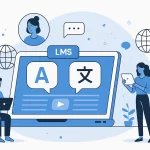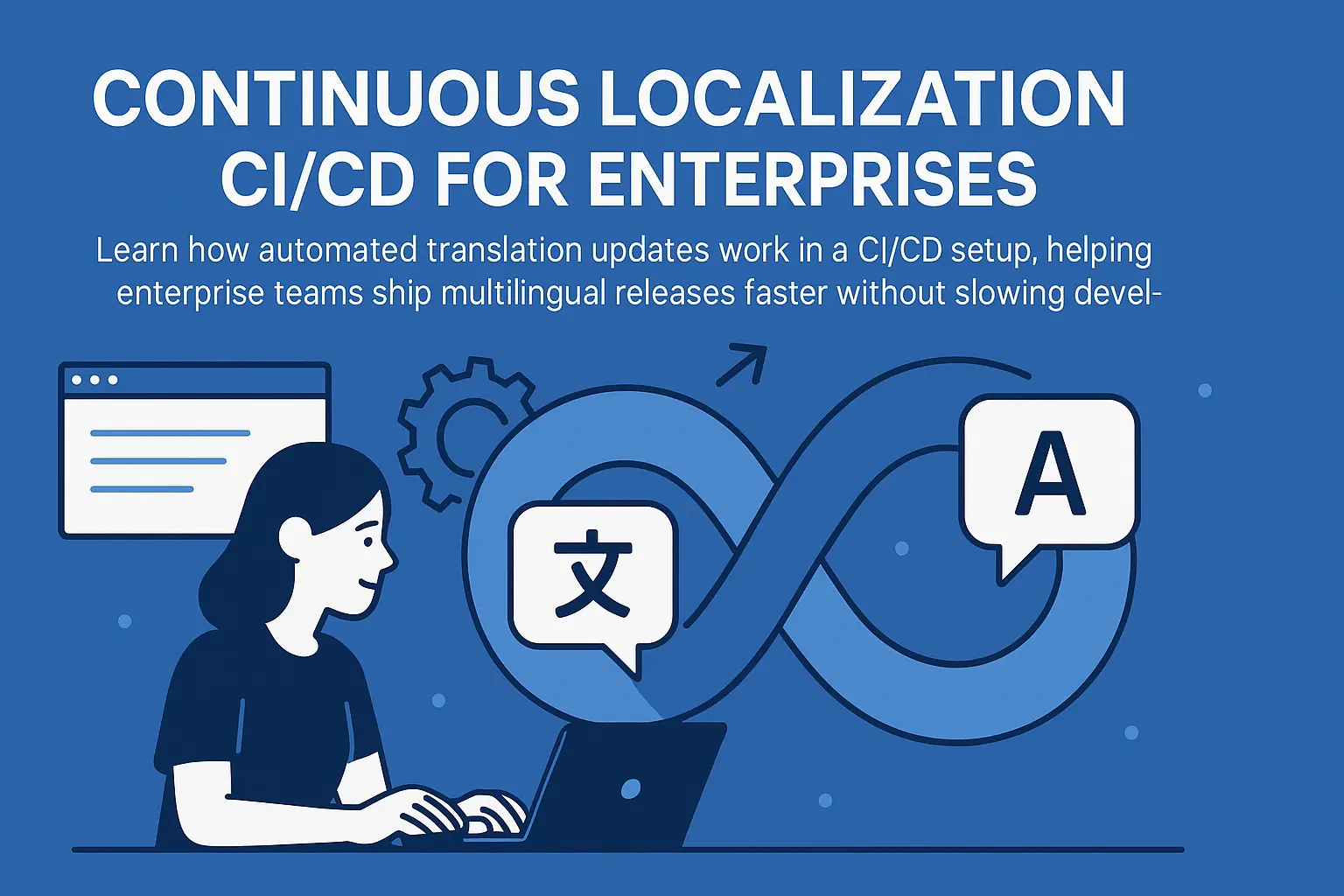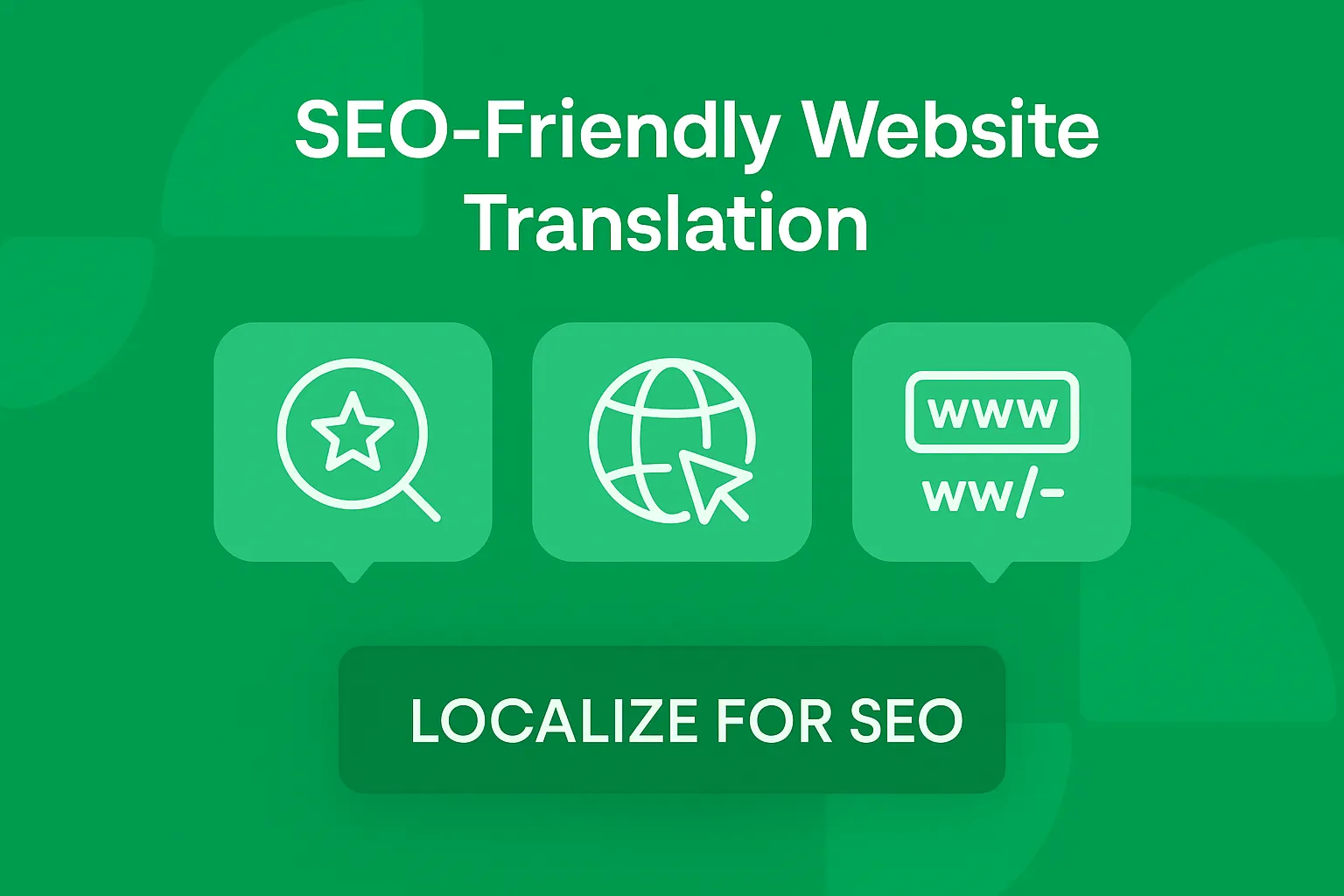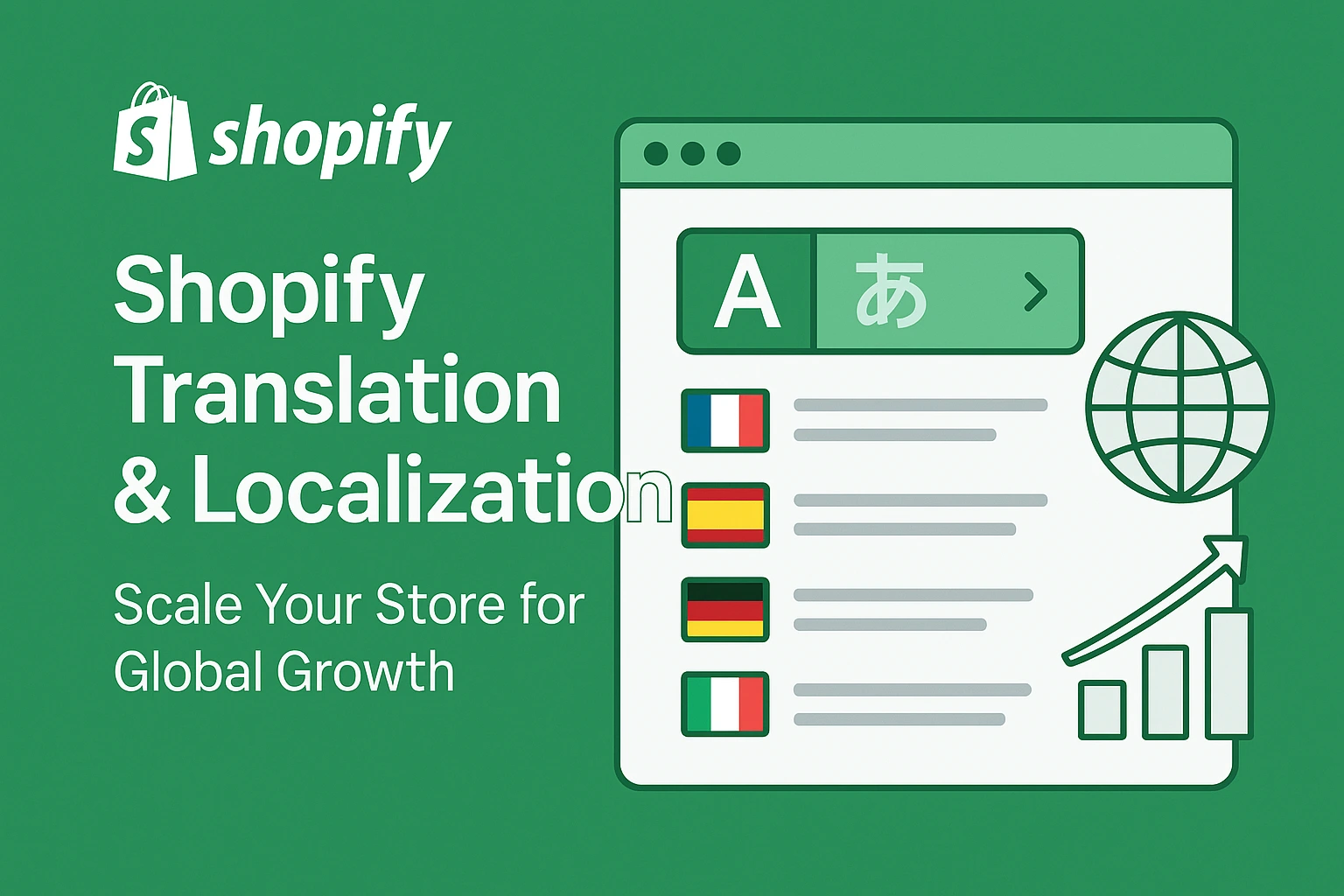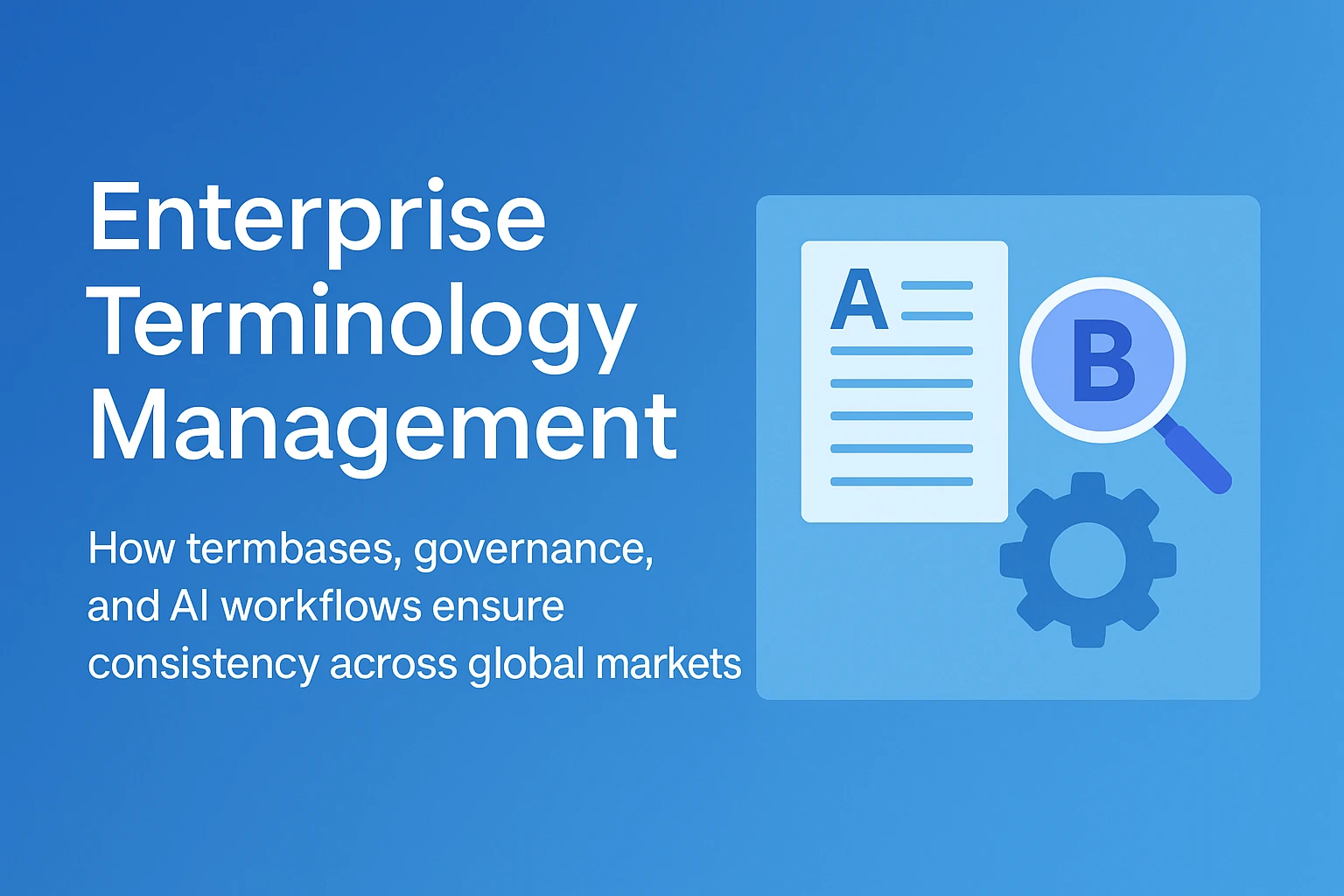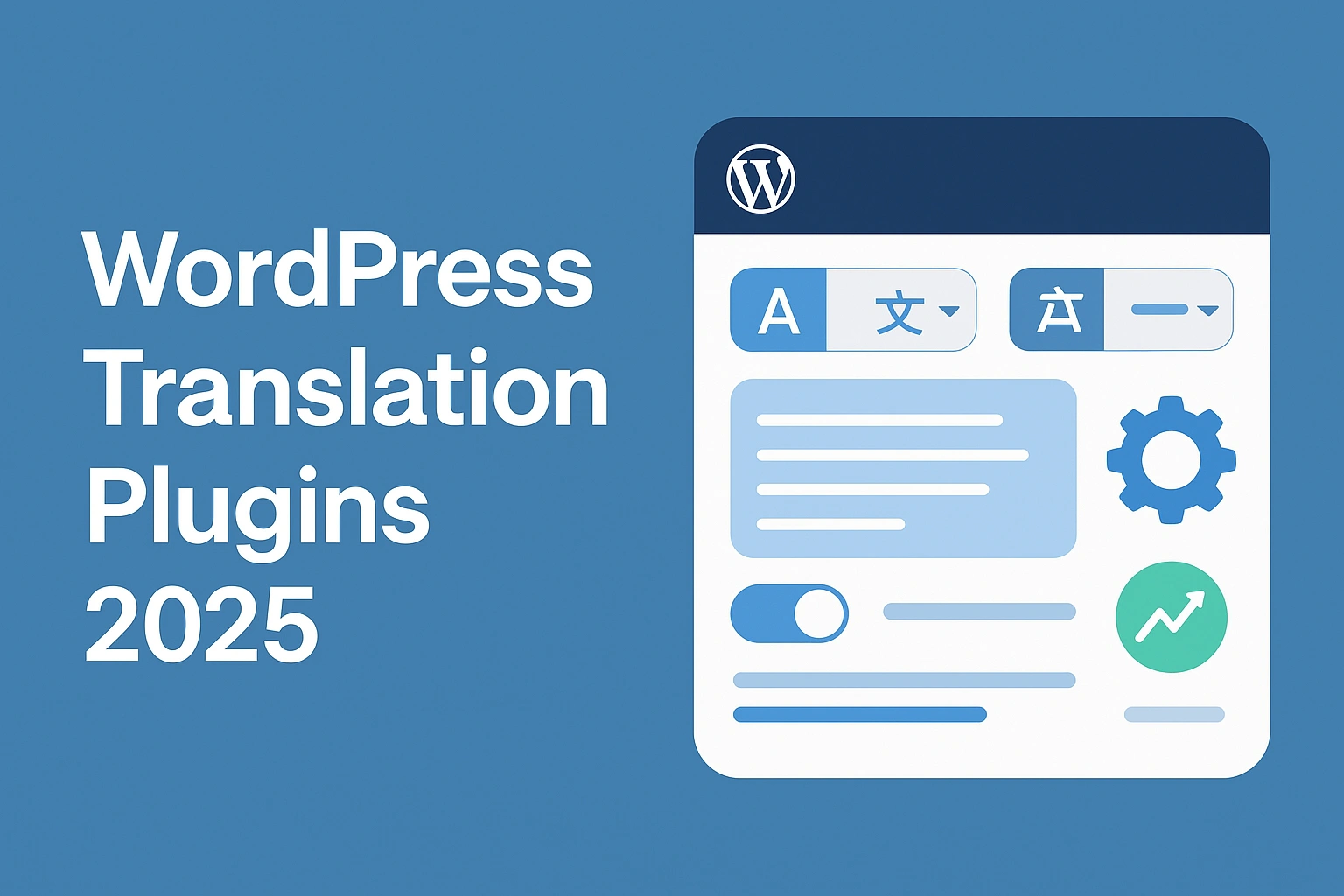Expanding globally is an immense challenge, and managing the multicultural content pipeline is but one of the challenges. To stay on top of things, an automated, continuous, and scalable localization engine that can keep up with the rigorous workload is essential.
Manual localization is incapable of matching the scale, and automated translation updates integrated into CI/CD pipelines eliminate these barriers.
By embedding translation tasks directly into your development and deployment cycles, you remove slow manual handoffs, reduce QA risk, and maintain multilingual parity across all your applications.
Through this article, you’ll learn everything about continuous localization, its application in enterprise saas or DevOps teams, and how you can implement it to keep your brand growth stable.
What Is CI/CD in Translation Workflows?
CI/CD (Continuous Integration and Continuous Deployment) is a DevOps methodology that automates the integration, testing, and deployment of every code change with minimal human intervention.
When this is embedded into the content pipeline, all the localization updates go through the same automated path as your development workflow. Every update is picked up, localized, and validated automatically across all supported languages. This ensures minimal manual handoffs in between.
This automated process takes the repetitive work off the manual workload, leaving room for tasks that require human attention. This way, you remove bottlenecks, reduce errors, and ensure multilingual parity across your applications.
What Are Automated Translation Updates?
Automated translation updates occur when your Translation Management System (TMS) connects directly to your content or software platform.
This allows for automated updates in your content across all supported languages, no manual handoffs needed.
With this setup, every new string or content update can:
- Sync automatically whenever content changes.
- Leverage Machine Translation (MT) and Translation Memory (TM) to speed up and standardize translations.
- Pass through quality checks without extra manual review steps.
- Deploy instantly across all supported languages.
This automated process forms the foundation of continuous localization, ensuring your content is always up-to-date in every language without bottlenecking the workflow.
How Automated Translation Fits into the CI/CD Workflow
A fully automated CI/CD-based translation pipeline follows a predictable sequence where every step is triggered programmatically, keeping localization aligned with every change and update.
Here’s what the sequence looks like:
- Source Updates Detected
Developers push new or updated strings, and the system automatically flags changes through version control triggers (Git commit, merge, branch update).
- TMS Auto-Sync
The Translation Management System pulls new strings instantly via webhook or API, eliminating manual file handoffs or exports.
- MT + TM Pre-Processing
Machine Translation and Translation Memory are applied automatically to generate initial translations, reduce repetitive work, and maintain consistency.
- Automated QA Validation
Quality gates check for formatting issues, placeholders, tags, character limits, glossary terms, and other linguistic or technical errors.
- Optional Human MTPE
Linguists step in only when needed, such as for customer-facing content (high-visibility releases) to refine and enhance the machine-generated output.
- Localized Content Returned to the Repo
Translated files are automatically pushed back to your codebase or product platform via API, keeping all locales aligned with source changes.
- Build & Deployment Across All Locales
The CI/CD pipeline incorporates all language versions in the build process, ensuring translations ship with every release, no delays, no bottlenecks.
Because this system is event-driven, each commit automatically triggers the entire localization sequence: extraction→ extraction → translation → validation → merge → deploy. In practice, teams often implement this with a lightweight GitHub/GitLab YAML workflow and visualize it using simple CI/CD pipeline diagrams to show how translation updates flow end-to-end.
Benefits for Product & Localization Teams
Translation automation integrated into CI/CD workflow is an irreplaceable asset to devOps teams. This delivers measurable ROI through decreased turnover and risks of manual handling. These accelerate release cycles by 50-70% as opposed to a fully manual workflow.
Centralized glossary and automated QA checks ensure consistency and minimize errors across large repositories and multi-app ecosystems. Errors are detected early on, resulting in fewer production defects. This creates a far more stable multilingual experience across all products and touchpoints.
As production scales globally, delegating resources efficiently becomes all the more important. By automating updates, localising teams do not have to waste time managing and coordinating files, and instead can focus on their actual tasks, leading to faster turnaround.
Key Components of Automated Translation Pipelines
A robust CI/CD-powered translation pipeline is built on a set of interconnected systems that automate every phase of localization. From extraction to deployment, all the cogs work in harmony to ensure localization is continuous, secure, and in sync across all languages.
Here are the 6 key components the automated translation system relies on:
- CI/CD-Ready TMS
A CI/CD-enabled TMS automatically detects new source strings, syncs them with your repo, and triggers translation workflows without manual steps. It manages languages, TM, glossaries, and MT routing so every update stays aligned with your builds.
- APIs & Webhooks
APIs and webhooks automate push-pull sync between your repo and TMS. They react to commits, merges, or releases, ensuring translations run in real time as part of your CI/CD pipeline.
- Machine Translation + MTPE
MT delivers instant draft translations using engines like DeepL or Azure. MTPE adds a human editor to refine accuracy, tone, and context, creating fast but high-quality outputs.
- Translation Memory & Glossaries
TM and glossaries reuse approved terminology and translations across all languages and products. This ensures consistency, reduces cost, and keeps your UI and content linguistically aligned.
- Automated QA / LQA
Automated QA checks placeholders, tags, string length, formatting, and glossary adherence before deployment. It prevents translation-related bugs from reaching production and cuts manual QA time.
- Security Layers
Security includes RBAC permissions, encrypted data flow, secret vaults for tokens, and full audit logging. Compliance with ISO, GDPR, and SOC 2 ensures safe, enterprise-grade localization.
Circle Translations uses a secure, integration-first workflow that incorporates all of these components to deliver reliable, automated translation updates for fast-moving software teams.
Translation Memory (TM) and Glossary Sync
An enterprise-ready Automated translation update system connects directly to your development ecosystem, such as GitHub, GitLab, Bitbucket, Azure DevOps, and Jenkins, using API automation and webhook triggers to detect new strings, sync up, and push updates across your multilingual repository.
Hybrid MTPE models offer maximum efficiency with minimum turnaround and error, through consistent glossary and accelerated release cycles. And the linguistic team would focus on the actual publishing part, also on the release and SEO end of things.
Machine Translation Engines in CI/CD
Modern teams typically integrate tools like DeepL API, Google Cloud Translation, Azure Translator, and Amazon to create a synchronized release cycle. Machine learning plays a big role in automating and performing the tedious tasks of the process, but the duality of the MTPE model allows for human inspections, ensuring absolute accuracy and security. Quality is continuously monitored using BLEU, TER, and COMET evaluation scores.
Automated QA and Validation Layers
Automated QA and LQAvlayers are crucial safeguards in CI/CD pipelines. They prevent minute mistakes, such as linguistic and formatting defects, early on. These validation systems check ICU placeholders, HTML/XML tag integrity, string length limits, truncation risks, forbidden terminology, duplicates, and key mismatches across languages to ensure every localized file meets technical and linguistic standards.
In CI/CD localization projects, Circle Translations typically sees a 35–45% productivity boost for engineering and localization teams once automated QA is added to the pipeline. This translates to a significant decrease in turnaround rate, errors, and meeting all the linguistic standards.
Security and Compliance in Automated Translation
Enterprise data are often sensitive and carry liability risk. So automated systems need to be implemented so as not to expose them. This includes internal configurations, proprietary feature strings, API tokens, customer data, and metadata embedded in JSON/YAML/XML files. CI/CD automation layers maintain strict security measures essential to prevent leaks, unauthorized access, or mistranslations. This automation reduces security-related review time by 25-35%, boosting ROI.
How to Ensure Data Security in CI/CD Pipelines
Modern CI/CD localization systems rely on a multilayered security system to protect your sensitive data. This spans across the entire workflow, from encryption to audit logs.
Let’s look into them:
- Encrypt Data in Transit & at Rest
Encryption is mandatory for protecting source strings, localized files, and metadata flowing through CI/CD and TMS systems.
- Enforce RBAC (Role-Based Access Control)
RBAC restricts which developers, translators, reviewers, or CI agents can access files, languages, or configurations.
- Store API Keys in Secure Vaults
API keys for Git, TMS, MT engines, and deployment systems should live in secure vaults instead of plaintext variables.
- Activate Full Audit Logging
Audit trails help meet ISO, GDPR, and SOC requirements by tracking translation events, file access, and automated actions.
- Use Secure Machine Translation (MT) Environments
Machine translation engines must process content securely, especially when handling sensitive strings.
- Apply String Filtering & Content Isolation
Sensitive strings (tokens, keys, secrets, configs) must be excluded from translation.
- Validate Localized Files with Automated QA
Automated LQA can prevent broken builds and runtime failures.
- Follow ISO 17100, GDPR & SOC Alignment
Certification and regulatory alignment ensure consistent, compliant handling of multilingual data.
- Restrict MTPE Access to NDA-Vetted Linguists
Human involvement must be controlled in CI/CD pipelines.
- Use Data-Retention & Auto-Deletion Policies
Limit how long translated versions, logs, and temp files are stored.
Sensitive strings, such as IDs, tokens, secrets, and config keys, are filtered through this multilayered approach, preventing accidental translation of critical values and reducing the risk of environment-breaking errors inside production builds.
Handling Sensitive Files and Configurations
In an automated pipeline, some files should never be translated. These are the most confidential files of a company, and translating them automatically poses a huge liability risk.
Using TMS-level tagging, pre-processing filters, and structured ignore rules, CI/CD localization systems automatically detect and skip these high-risk fields. Circle Translations configures these rules during onboarding, ensuring that only translatable content is processed while all sensitive system data remains protected.
Best Practices for Implementing Automated Translation Updates
Automating the translation updates requires a structured rollout. Each step is labeled clearly, filling in the unique gaps each step requires.
Here is the step-by-step guide to best practices when it comes to automated translation updates:
- Run a Full Localization Audit
Begin by assessing all source files, repositories, string formats, environments, and content owners. Identify the string’s location, rate of change, and owner.
This gives you a clear map of what needs to be automated and which integrations will matter most.
- Select a CI/CD-Ready Translation Management System (TMS)
Choose a TMS that supports automated workflows, Git-based sync, API endpoints, webhooks, and continuous localization capabilities.
Platforms like Lokalise, Phrase, Crowdin, Smartling, and Localazy are built for engineering teams and integrate cleanly into DevOps environments.
- Connect Repositories to the TMS
Set up automated push-pull synchronization so new or updated strings are detected instantly. This includes connecting GitHub, GitLab, Bitbucket, or Azure DevOps repositories, configuring branch rules, and enabling webhook triggers.
Once active, your TMS becomes the single source of truth for all localized resources.
- Configure Machine Translation, TM, and Glossary Rules
Establish MT routing (DeepL, Google, Azure), enable Translation Memory usage, and enforce glossary rules to maintain terminology consistency.
MTPE workflows can then refine quality when needed. This ensures every update follows a predictable, reusable pattern instead of starting from scratch.
- Build Automated QA & Validation Layers
Add validation rules for placeholders, HTML/XML tags, key matching, ICU formats, and glossary consistency. This prevents errors before they reach staging or production.
With this in place, translation defects are caught early, reducing downstream rework.
- Test the Pipeline in a Staging Environment
Before going live, run staging builds to test localization triggers, MT behavior, QA rules, file integrity, and deployment paths. This helps catch issues like broken keys, missing locales, or incorrectly translated configuration strings.
- Deploy the System & Monitor It Continuously
After validating your setup, move to production and monitor pipeline behavior: translation jobs, LQA results, sync logs, and MTPE throughput.
Track speed, failure points, and quality improvements over time.
- Optimize Based on Usage, Volume & Scaling Needs
Over time, refine your MT engines, update glossary versions, adjust QA thresholds, and expand automation to new repositories or apps. As your product grows, your localization pipeline should evolve with it.
Enterprises often extend automation across multiple microservices, platforms, and content types.
Choosing the Right TMS for CI/CD Integration
Your translation automation should work with your current workflow and speed it up. So, choosing the right partner is very important. Different enterprise providers specialise in different areas of the workflow.
Which one is perfect for you?
– Let’s look at the table below that summarizes the top providers within a few key metrics:
| TMS | Strengths | CI/CD Support | Best For |
| Lokalise | Strong automation tools | API, CLI, Git sync | SaaS startups to enterprise teams |
| Phrase | Powerful MT + workflows | GitHub Actions, API | Engineering-heavy organizations |
| Crowdin | Multi-project orchestration | CLI + Git-based sync | Complex enterprise ecosystems |
| Smartling | Enterprise-grade QA | Custom connectors, API | Regulated industries (finance, legal) |
| Localazy | Token-based developer control | API, Git | Developer-centric teams |
Setting Quality Gates and Triggers
There are quality gates put in various points throughout the pipeline. These gates typically require ≥90% translation coverage, zero validation errors, no glossary violations, and an MTPE approval score of at least 85% to ensure linguistic consistency.
These checks prevent defective translations and keep the integrity of the brand voice intact.
Scaling Across Multiple Repositories or Apps
Localization scales across multiple repositories, applications, and product lines as organizations scale across multilingual markets. This is achieved through TMS multi-project linking, webhook orchestration, or translation proxy architectures that sit between systems and automatically deliver localized content. Even then, bigger organizations require more complex multi-repo structures with centralized TM+Glossary systems.
Circle Translations specializes in multi-repo orchestration, ensuring that terminology, translation memory, and CI/CD automation remain consistent across your entire product ecosystem, across 120+ languages.
ROI of Automated Translation Updates in CI/CD
ROI = ((Manual hours saved × hourly rate) – setup cost) / setup cost
This formula shows that ROI is measured directly through saving time and labour. Reduced engineering time, faster multilingual release cycles, lower QA overhead, and more consistent translation output result in boosted numbers that show a growing trend in the organization.
The best and most efficient way to delegate resources in a way that minimizes both is to automate the translation updates. This reduces turnaround time by removing manual handling in between, and reduces labour by reducing it to QAs.
Quantifying ROI for Continuous Localization
Continuous localization minimizes manual handling of the files between each step. This reduces prep time, requires fewer labour resources, and cuts cost measurably without sacrificing quality, and boosts ROI in the process.
Here’s a snapshot of what that looks like:
| Metric | Before Automation | After Automation | Gain |
| Release Prep Time | 4–7 days | 1–2 days | 70% faster |
| Engineering File Handling | 10–20 hrs/mo | 1–2 hrs/mo | 85% reduction |
| QA Validation Time | High | Low | 40–50% lower |
| New Locale Launch | 2–3 weeks | 3–5 days | 60% faster |
| Consistency Errors | Frequent | Rare | 80–90% reduction |
Hidden Costs and Maintenance Factors
Automation is truly a blessing for organizations scaling internationally. However, there are unexpected costs like maintenance. This influences long-term ROI.
Unexpected costs include:
- Outdated glossaries, which can cause terminology drift across products
- MT engines are losing accuracy over time due to shifting product terminology
- Missing human QA oversight, leading to subtle quality gaps
- Multi-repo inconsistencies, where different teams maintain divergent language structures
To reduce these issues, Circle Translations offers Review-as-a-Service, providing continuous glossary updates, TM optimization, MTPE quality checks, and periodic LQA audits. This ensures your organization can scale without taking a major hit in your ROI.
Why Choose Circle Translations for Automated Localization Workflows
Global products demand fast, reliable, and consistent localization. Circle Translations is uniquely positioned as a tech-first, integration-focused localization partner, combining human expertise with automation to ensure your releases are multilingual, on time, and of high quality.
Our Human + MTPE + Automation Framework
Circle’s hybrid approach blends linguist-led post-editing, machine translation, and CI/CD integration to deliver speed, stability, and consistent quality.
Key capabilities include:
- Custom API and webhook setups
- Developer collaboration for seamless integration
- Automated QA engineering
- MTPE-trained linguists for high-quality output
- ISO-certified security practices
- 24/7 project management coverage
Integration Expertise and Custom Engineering
We tailor every solution to fit your workflow and technical environment. From simple repository setups to complex multi-repo architectures, our engineers ensure every translation process is automated, scalable, and fully integrated.
Key offerings include:
- Repository-specific automation scripts
- Custom connectors for any TMS
- Multi-repo orchestration architectures
- CI/CD pipelines with translation-specific jobs
- Cloud and on-premise localization setups
Continuous Support and Optimization
Localization is never “set it and forget it.” Circle Translations ensures ongoing performance, quality, and scalability through a combination of routine maintenance and proactive optimization.
Here’s what you can expect:
- Weekly MT quality checks
- Glossary governance
- Automatic TM defragmentation
- QA audit reports
- MT model updates
- Release support aligned with your development cycles
Conclusion
Automated translation updates have now become a competitive necessity, rather than an optional choice. CI/CD integration ensures a flawless, speedy transition between each step. In doing so, more resources and time can be delegated towards tasks that matter.
While engineers focus on their task at hand, seamless automated transitions make the workflow smoother overall. With this technology, you can scale globally and still keep your workflow efficient, and still have a measurable increase in ROI.
Circle Translations delivers the technology, workflows, and expertise needed to build and maintain these automation frameworks. With secure, integration-first engineering, MTPE-backed quality, robust QA layers, and ongoing optimization, Circle helps companies scale continuous localization with confidence.
Contact Circle Translations to implement secure, automated translation workflows that fit your CI/CD environment.
Frequently Asked Questions
How do automated translation updates work?
Ans: Automated translation updates work by connecting your code repository to a translation management system (TMS). When a developer commits new text, the TMS automatically pulls the updated strings and runs them through your translation memory and machine-assisted suggestions. The system then performs quality checks before sending the translated files back into the repository. Once they’re synced, your CI/CD pipeline deploys the updated content without manual steps.
What are the benefits for software teams?
Teams mainly benefit from faster multilingual releases and fewer bottlenecks. Because everything is automated, engineers no longer handle files by hand or wait for back-and-forth steps. Terminology stays consistent, UI errors drop thanks to automated QA, and the whole process becomes more predictable and transparent. This reduces overhead while keeping release cycles tight and aligned with feature development.
Is automated translation secure for enterprise use?
In short, yes. With a proper enterprise-grade TMS, everything is encrypted end-to-end, access is permission-controlled, and credentials are stored securely. Providers also operate under GDPR/ISO certifications and use vetted linguists and protected environments. This level of security works even for fintech, healthcare, and large-scale cloud platforms.
Which tools integrate best?
Platforms like Lokalise, Phrase, Crowdin, and Smartling plug into Git-based workflows smoothly. They support APIs, webhooks, and direct repo sync. Machine translation can come from DeepL, Google, Azure, or Amazon. CI/CD tools such as GitHub Actions, GitLab CI, Jenkins, or Azure DevOps can trigger localization automatically as part of your build or deployment steps.
How is translation quality measured in CI/CD?
Ans: Quality in automated translation pipelines is maintained through MT scoring, computerized checks for tags, placeholders, formatting, and strict glossary control. Human post-editing is applied to sensitive content, and regression checks ensure consistency in terminology across releases. This approach ensures that updates remain accurate without slowing down delivery.
In practice, you want faster releases, automated file handling, consistent terminology, protected user experience through automated checks, and clear logs that reduce operational overhead.
Can Circle Translations integrate with our existing CI/CD system?
Ans: Yes, it’s safe when the TMS and provider follow enterprise-grade security standards. This includes encrypted API connections, role-based access, and secure token storage, as well as GDPR- and ISO-compliant workflows. Linguists work under NDAs, and internal processes follow SOC 2 practices. These controls make the setup suitable for fintech, healthcare, and enterprise SaaS environments.





